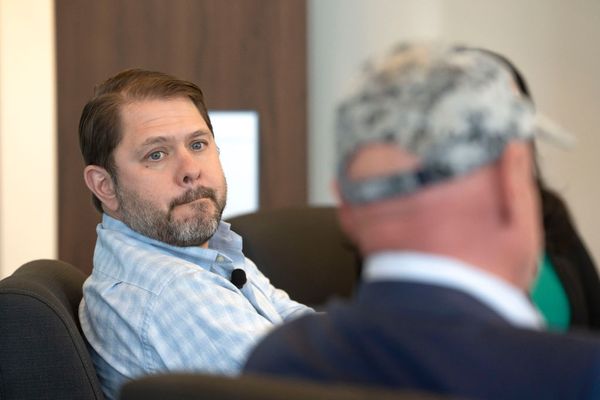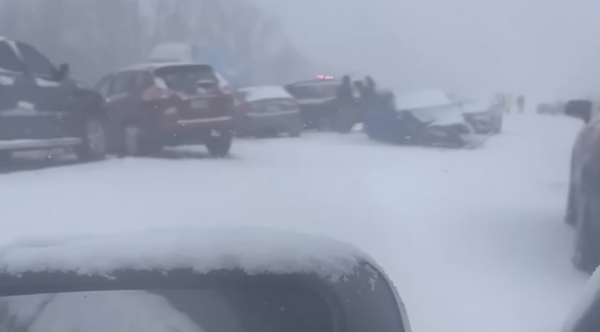
Michelin has been at the forefront of tire technology since it introduced the first radial, the X, in 1946. The company has also been making and developing tires in North America since the mid-1970s, and for about a year now, Matthew Cabe has run Michelin North America.
Cabe is new to this particular job, but not to Michelin, with over 20 years at the company. (Something that’s common at Michelin.) His background is in engineering, and he’s all too excited to get into the nitty-gritty of tire development.
We spoke about how simulation and finite element analysis have changed tire development, and how 3D printing and AI are unlocking previously unheard-of possibilities. But as Cabe notes—it's not about the tools, it's about what the tools allow people to do. (The following conversation has been lightly edited for clarity and length.)
State of Motion
Welcome to State of Motion, where we sit down with automotive industry leaders to discuss where the car world is headed. Expect insight and candor from those defining the future of the car.
Motor1: You’ve been with Michelin a long time, 20 years. How has tire development changed in that time?
Matthew Cabe: We’re becoming much faster. I’m a mechanical engineer, and when I came in, the finite element analysis that we had, you would run a program, it would take eight hours. You’d sleep overnight, and it would run. Today, those are the kind of things that happen in a minute.
So, the processing power, the fact that we can use all of these tools to just help us get to the solution quicker and do some of those basic steps, helps us to make our way through the process much faster than we ever have. And now, we’re able to ask different questions than we were in the past.
If you can run five simulations at the same time, and it comes back and gives you the comparative analysis between these different things, then you can choose a path and you can start to go. It unlocks a new level of creativity because if you can test your hypothesis quickly and you can find different opportunities to be able to apply something that you've been thinking about, well, now maybe it can become a reality. Where before, due to the time it would take us to get there, we were a little more hesitant to say, ‘Okay, let’s go try this.’ It’s helping unlock great creativity.
What are some of the different questions you’re asking?
Well, one of the areas that I would talk about would be the all-weather category. You see the all-weather category exploding. Twenty years ago, it was ‘How do we make a better mud-and-snow tire? How do we make a tire that can be good in wet, and also be okay in snow,’ or whatever the combination of elements we were looking for?
Now we’re saying not only can we produce a tire that is good in wet, that is a great daily driver through the summer, but we get three-peak mountain snowflake, and we can be playing in a space that for, not everyone, but a vast portion of the population feels confident to go out when they get that yearly snow, or if they get snow a couple times a year and they can feel confident that the product they’ve got is safe.
When we talk about trying things, before, it was ‘How do we get a little bit better in each of those other categories?’ But now we’re taking leaps and saying, ‘How do we unlock something that we didn’t do in the past?’

Obviously, you can't get rid of certain compromises. But those compromises are getting a lot smaller, and the breadth of ability in a tire is getting a lot bigger.
We think about it as a string. So if you plot all of those different elements that we’re trying to optimize for—rolling resistance, dry braking, hydroplaning, snow, etc.— what you end up with is what we call a spider chart. And in that spider chart, we used to have to play with the length of a circle that was like this [mimes a small circle]. Well, now we’re able to make the length of the string much longer.
Michelin, we pride ourselves on "Total Performance," so trying not to be great in one thing and really mediocre in a lot of others. Yes, depending on the product, we’re going to lean a bit heavier—an all-weather product, that’s going to be a little better in snow than some others, but we’re not going to leave behind the rolling resistance and those other things to get there because that’s not what we believe the consumer wants. We believe they want the total performance package.
So, as we go through this—which is really cool from an engineering perspective—what is the great unlocker that can help us make that string longer, so we can hit more points and get that performance we want without losing the one that’s on the other side?
That great unlocker is simulation tools, and I would imagine there’s probably a lot of breakthroughs in compounding. I know simulating compounds is one of the hardest things to do.
But what you can do with the technology side there, if you have tests that are repeatable, what we couldn't do 20 years ago is you can set up tests to run all night while you're not there. And then you come back the next day, and you've got a series of tests, and now you can say, okay ‘Lets crunch this data.’

Obviously, the data-crunching piece is much further advanced than it was then. But now, you can set up automated routines so that you can come back and [the computer] does things for you overnight, or for weeks on end that we couldn’t have done before. We can put it in a dark room and let it go, you know, do some crazy test for a while, and then we come back and we're like, ‘Okay, what happened over that time?’
Twenty years ago, processing power, memory, and things like that were a limit for us to be able to capture every millisecond the level of data we need because it would generate files that were just too big to handle. Well, today we can do that. We load it into the cloud, and we have the opportunity to look back at what happened over time. So, it’s really helping us to be more innovative.
Now that you’re unlocking all these different possibilities, you can try different stuff from what you did before. How do you manage that level of complexity?
We break it into steps. In the very beginning, we don't set out to just make a better sidewall. What we do is we have teams of people that are working on ‘How do we get a different property in the compound?’ For years and years, they continue to focus on, ‘How do I get less heat generated by the movement of the compound?’ or something along those lines.
Further downstream, you have other people that are in touch with marketing, they're saying, ‘Okay, if I'm going to make an all-weather tire, what does that look like?’ And so the marketing team comes in and says, ‘Okay, I want an all-weather tire: Here's what I'm looking for.’
Then there's another group that's taking this kind of library of crazy innovations that are coming up. For example, we decided they were going to put some kind of organic compound into our rubber that we've never done before. We came up with this really innovative thing, but in the beginning, we don’t know what it’s going to be for. We have no idea. We didn't set out to design a new sidewall, it was ‘What can we do?’
Then this next team takes this library and says, ‘What can I pull out of what they’ve learned, and inject that into what I’ve got so that way we can build the next product?’ So, we take it in those steps, where it’s not one person that starts 15 years ahead and says, ‘How am I going to develop this one product?’
Because we have the full breadth of products, everything from passenger-car tires to agricultural tires, through mining, through trucks, we can start to see how we can use some of those technologies that started in one place, and how they can start to make their way through the journey in other places. And sometimes, it comes back with something we never expected.
I want to talk about AI. Everyone’s talking about AI all the time, and everyone feels pressure to talk about it, but where do you see it impacting tire development?
We’ve talked about simulation a little bit, but now you can start to apply AI to fully completed tires. So, how can we introduce different scenarios to test our tires with AI? Traditionally, without AI, introducing variables into your program can be difficult. What AI can do, if you feed it the right way, is take a combination of variables and feed those into your simulation.
We are very, very far away from being able to, say ‘Design me a tire that looks like this,’ and for AI to somehow come back with this combination of elements. What we can do is use it at different steps to help us.
One example that I have in mind is when you look at large data sets, humans can identify patterns, but AI can also identify patterns, and sometimes it can identify patterns that we didn't see. It puts us on a new path to be able to go look at something we didn’t just correlate before. What AI can do is help us correlate these different elements.
It’s not about asking it to develop a tire, it’s about, ‘I’ve got these massive data sets, what correlation do you see between these two seemingly unconnected tests?’ And then it may come back and be like ‘Every time that it’s 32 degrees outside, this peaks and these three different things.’ Looking through all that data and being able to combine that would be really complex for a human to get to.
And if it can say there is a correlation, then our engineers can take it to the next step and say, ‘Okay, why that correlation? What might have caused that? What can we do? Can we make that happen again, and then how can we use it to our advantage?’
I think it acts as a compliment to us to be able to treat data in a different way so that we can analyze it and then keep pulling the string. It’s all about helping us to see where we can push a little harder.
Especially, too, as you have more and more data than ever before.
In the past, you could think of conditional formatting as a way to look for an anomaly. But it's really hard to get from just that anomaly to a correlation between a lot of different data sets, and if you can get to the place where you can see those correlations, it can be powerful.
I want to switch things up and talk about 3D-printing a bit and how that impacts tire manufacturing, something you and I have talked about previously.
There are a few different areas to lean into there. One, the lunar tire that we're looking to put in the market, it can be 3D printed. Obviously, our Vision tire, our initial concept there is a fully sustainable product that has been 3D-printed. So that's kind of like, ‘Where can we get to far away from where we are right now?’
I remember the commercial, maybe you saw that video, where they rolled the Vision tire into a box and it got a retread printed back on it, then it rolls on. Those kinds of things, although they seem a bit way out there, Jetsons kind of era, it’s not so unreasonable. Some of those things come into play.

You talk about being able to make molds or different parts, the creativity that you can have as an engineer when you're not constrained by traditional machining practices is unbelievable.
I say this all the time: When I first became an engineer, I designed some parts that couldn't be manufactured, and I would go and I would sit with the machinist, and they would be like ‘Look, if you want to do this, your tool has to come in this way and then it would have to go through the middle of your part and then go this way. And that's just not possible. There’s no physical path for me to be able to do that.’ That’s not a limitation anymore.
So, when you can 3D print all kinds of different materials—metals, and obviously different kinds of polymers—you can unlock a level of creativity in the engineer that we haven't gotten to yet. This goes for molds, it goes for the equipment we have in our plants. It goes for a lot of things where you can make the equipment more robust. You can create shapes, maybe in tires, that we could never create before.
It's really aligned with what we talked about there in the simulation. It's just another way to unlock the creativity for us to be able to try something that was never possible before.

The last thing I wanted to ask about is EV tires. Michelin doesn’t do a lot of EV-specific tires. Why is that?
It's a great question and one that we wrestled with. In the end, it’s a choice, and the choice we decided to make comes back to this “Total Performance.” We think that if a consumer is coming to get one of our products and it is the right size for their vehicle and has the right proportions, we want them to be able to have that product that matches.
The things that EV drivers care about, we also care about. Every tire we develop, we're looking for better rolling resistance, which leads to range. And longevity. Longevity is a big question in the EV space, but it’s also a big question of others.
Whether you own an EV, or a hybrid, or a traditional ICE car, we want to be able to provide you with that product. And honestly, make it less complex for the consumer who already has a lot of different choices. So we say, ‘You know what? We know that your needs align a lot with the needs of the other consumers, and we're going to build a product that's going to work for all of it.’ And we can, so we're going to deliver that.
We think that the things that they care about in the EV space are also cared about in the ICE space. Maybe looked at it a little differently, but we feel like by doing that, it makes it easier for the consumer, and we can still deliver on what they're looking for.








